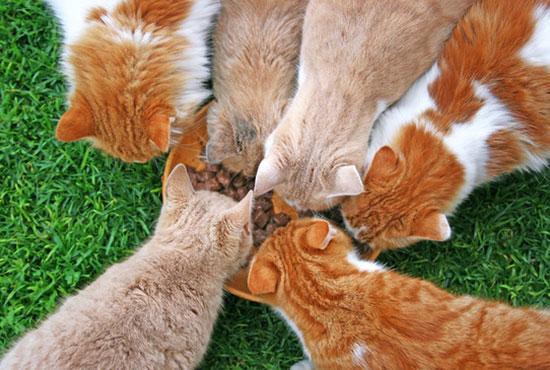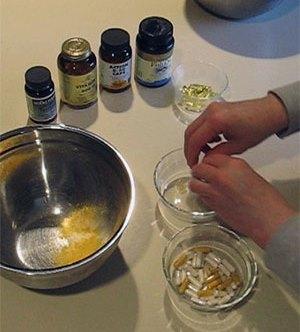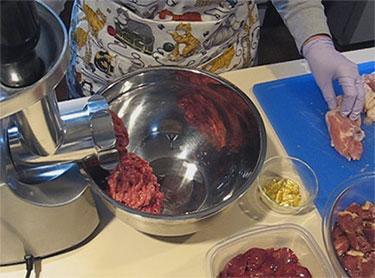This content is archived from the Feline Nutrition Foundation
Homemade Cat Food, a Balancing Act
- Updated: Sunday, June 02, 2019 02:33 PM
- Published: Saturday, February 08, 2014 08:03 PM
- Written by Marta Kaspar
 I am confused about supplements. I make homemade raw cat food and I noticed that the recipe I use does not call for some of the vitamins, such as iron, zinc, and folic acid that are included in some prepared premixes. Is this a problem? How can I be sure my recipe won't be vitamin deficient?
I am confused about supplements. I make homemade raw cat food and I noticed that the recipe I use does not call for some of the vitamins, such as iron, zinc, and folic acid that are included in some prepared premixes. Is this a problem? How can I be sure my recipe won't be vitamin deficient?
If you have ever been interested in nutritional science, I am sure you have come across the term "balanced diet." But what does it actually mean? According to a common definition, it is a diet that contains adequate amounts of all necessary nutrients required for healthy growth and activity. Sounds pretty straightforward, doesn't it? What makes this statement more complicated in the world of cat nutrition is that almost every country has its own guidelines for all of the necessary nutrients, and recommended nutrient ranges can vary greatly. Most pet food companies in the United States comply with the Association of American Feed Control Officials guidelines. But are AAFCO's nutrient recommendations the best nutrient ranges for our cats? I don't think anybody can answer this question. What I am trying to say is that any nutrient level ranges should serve only as guidelines and not as absolute numbers.
But let's go back to the original question. While I can't speak for all the suppliers of prepared supplement premixes, the reason why some of the vitamins, such as iron, zinc and folic acid are added to our products is that these premixes need to be versatile. They need to ensure a balanced diet for all kinds of meats and fill all of the nutritional gaps in foods with wide calorie ranges. Premix versatility is especially important in case someone is not able to provide a good food variety for their cats.
 Homemade recipes will vary in the supplements they call for, as will prepared premixes. This does not indicate that one is deficient compared to another. Some vitamins might not be included because the meat itself would provide the amounts needed. Since all nutrient requirements fall into a range, rather than absolute numbers, adding to the naturally occurring vitamins will ensure that enough is provided.
Homemade recipes will vary in the supplements they call for, as will prepared premixes. This does not indicate that one is deficient compared to another. Some vitamins might not be included because the meat itself would provide the amounts needed. Since all nutrient requirements fall into a range, rather than absolute numbers, adding to the naturally occurring vitamins will ensure that enough is provided.
I have been involved in cat nutrition for a long time and have calculated nutrient profiles for countless recipes. What I have learned during those years is that it is not always just the numbers that matter. A lot of it is common sense. I've also learned that you don't need have to have an advanced degree to feed a healthy raw diet for cats. You just need to pay attention to a couple of simple rules. Here are some basics you should know if you prepare homemade raw cat food:
Cats Need a High-Protein Diet
Cats are obligate carnivores. They need a high-protein, meat-based diet to thrive and do well. A low-protein, high-carbohydrate diet is not suitable for them. There's no such thing as a vegan cat.
Diets Without Any Additional Supplementation
Animals, especially cats, have unique dietary needs. In the wild, they would instinctively seek and find all the nutrients they need. However, our indoor pets depend entirely on us to give them the proper diet. Frankenprey or whole-prey diets try to mimic the food that would cats eat in the wild. These diets use no ground meats at all. They are made of whole meats, bones and organs and usually don't require any additional supplementation. They are probably the healthiest diets for cats but involve very careful planning and the cats have to be willing to eat all of the required meat varieties including the bone-in cuts.
Diets with Additional Supplementation
Almost all raw cat food diets other than frankenprey or whole prey, should have certain supplements added to fill the nutritional gaps created by meat processing, using only limited cuts from the animal or removing the bones from the diet. Even if you are feeding whole carcass grinds it is safer to add some supplements, because it's not really known what kind of nutrient losses occur from grinding and storage. Here are the basic guidelines:

- Always add liver and taurine. Almost all diets that are boneless or have bones, are cooked or raw, should have small amounts of liver and taurine added.
- Add calcium to boneless meat. Although boneless meat alone has almost all the nutrients your cat needs for healthy growth and activity, it has almost no calcium. Therefore, if you decide to feed your cat boneless meat, you always have to add calcium.
Meat Variety is Important
If you are not adding a prepared premix to your cat's homemade diet, but you are adding vitamins individually, be aware that meat might or might not be slightly low in some other minerals and vitamins B and E. This depends on small deficiencies that particular meats might have. These insufficiencies can be evened out by increasing meat variety.
Choose the Right Supplements
If you want to make your own raw cat food with the help of a prepared multivitamin supplement premix, use only those premixes designed for homemade pet diets. Different products have slightly different compositions. It might be a good idea to change the brands from time to time, as this can help even out the nutrient profile in addition to feeding a variety of meats. If a premix is labeled for use with boneless meats, then you don't need to worry about adding additional calcium because it is already included. Generic pet supplements or multivitamins designed for human consumption should not be used in homemade raw diets for cats. Individual human-grade vitamins should be added only in amounts called for in a homemade raw cat food recipe.
More Doesn't Always Mean Better
With some vitamins, it might be safer to have your homemade diet slightly under-supplemented than considerably over-supplemented. Be especially careful with fat-soluble vitamins such as vitamins D and A. Avoid adding these in concentrated forms altogether.
Additional Reading
Answers: Raw Cat Food for All of Those Kittens!
Falling Off the Cat Food Recipe Cliff
Pay Attention to Your Cat
The quality of any diet will likely have a visible effect on your cat. Try to pay close attention and monitor weight variations, the quality of your cat's coat, changes in drinking habits and activity level.
Note: Feline Nutrition provides feline health and nutrition information as a public service. Diagnosis and treatment of specific conditions should always be in consultation with your own veterinarian. Feline Nutrition disclaims all warranties and liability related to the veterinary advice and information provided on this site.
Marta Kaspar holds a master's degree in chemistry from the University of Pardubice in the Czech Republic. She is a research scientist, and a formulation and analytical chemist in both industrial and academic fields. Marta became interested in feline nutrition when her cats developed health problems. When she decided to prepare their food herself, the effect of the homemade raw meat diet on her cats was so impressive that she created the line of Alnutrin® supplements to help others transition their cats to better diets. You can find her atknowwhatyoufeed.com.




